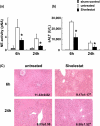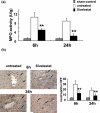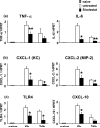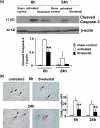The protective function of neutrophil elastase inhibitor in liver ischemia/reperfusion injury
- PMID: 20160675
- PMCID: PMC3627371
- DOI: 10.1097/TP.0b013e3181d45a98
The protective function of neutrophil elastase inhibitor in liver ischemia/reperfusion injury
Abstract
BACKGROUND.: A neutrophil elastase (NE) inhibitor, Sivelestat, has been approved for the treatment of acute lung injury associated with systemic inflammation in humans. Some reports have also shown its protective effects in liver inflammatory states. We have recently documented the importance of NE in the pathophysiology of liver ischemia/reperfusion injury, a local Ag-independent inflammation response. This study was designed to explore putative cytoprotective functions of clinically available Sivelestat in liver ischemia/reperfusion injury. METHODS.: Partial warm ischemia was produced in the left and middle hepatic lobes of C57BL/6 mice for 90 min, followed by 6 or 24 hr of reperfusion. The mice were given Sivelestat (100 mg/kg, subcutaneous) at 10 min before ischemia, 10 min before reperfusion, and at 1 and 3 hr of reperfusion thereafter. RESULTS.: Sivelestat treatment significantly reduced serum alanine aminotransferase levels and NE activity, when compared with controls. Histological liver examination has revealed that unlike in controls, Sivelestat ameliorated the hepatocellular damage and decreased local neutrophil activity and infiltration. The expression of proinflammatory cytokines (tumor necrosis factor-alpha and interleukin-6), chemokines (CXCL-1, CXCL-2, and CXCL-10), and toll-like receptor 4 was significantly reduced in the treatment group, along with diminished apoptosis through caspase-3 pathway. Moreover, in vitro studies confirmed downregulation of proinflammatory cytokine and chemokine programs in mouse macrophage cell cultures, along with depression of innate toll-like receptor 4 signaling. CONCLUSION.: Sivelestat-mediated NE inhibition may represent an effective therapeutic option in liver transplantation and other inflammation disease states.
Figures






Comment in
-
Effects of neutrophil elastase inhibitor on progression of acute lung injury after liver transplantation.Transplantation. 2010 Aug 15;90(3):335-7. doi: 10.1097/TP.0b013e3181e49bf2. Transplantation. 2010. PMID: 20683430 Clinical Trial. No abstract available.
References
-
- Farmer DG, Amersi F, Kupiec-Weglinski JW, Busuttil RW. Current status of ischemia and reperfusion injury in the liver. Transplant Rev. 2000;14:106.
-
- Teoh NC, Farrell GC. Hepatic ischemia reperfusion injury: Pathogenic mechanisms and basis for hepatoprotection. J Gastroenterol Hepatol. 2003;18:891. - PubMed
-
- O'Neill LA. Therapeutic targeting of Toll-like receptors for inflammatory and infectious diseases. Curr Opin Pharmacol. 2003;3:396. - PubMed
-
- Obhrai J, Goldstein DR. The role of toll-like receptors in solid organ transplantation. Transplantation. 2006;81:497. - PubMed
Publication types
MeSH terms
Substances
Grants and funding
LinkOut - more resources
Full Text Sources
Research Materials

